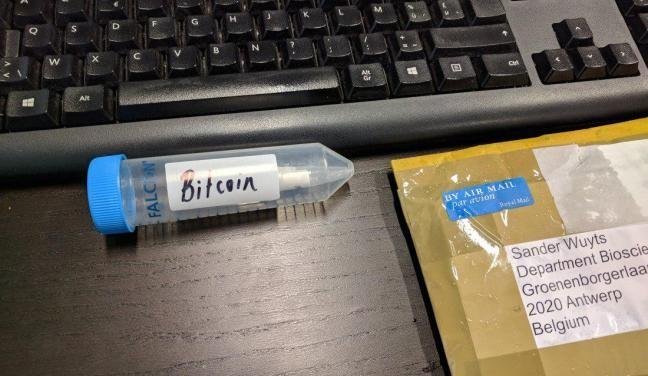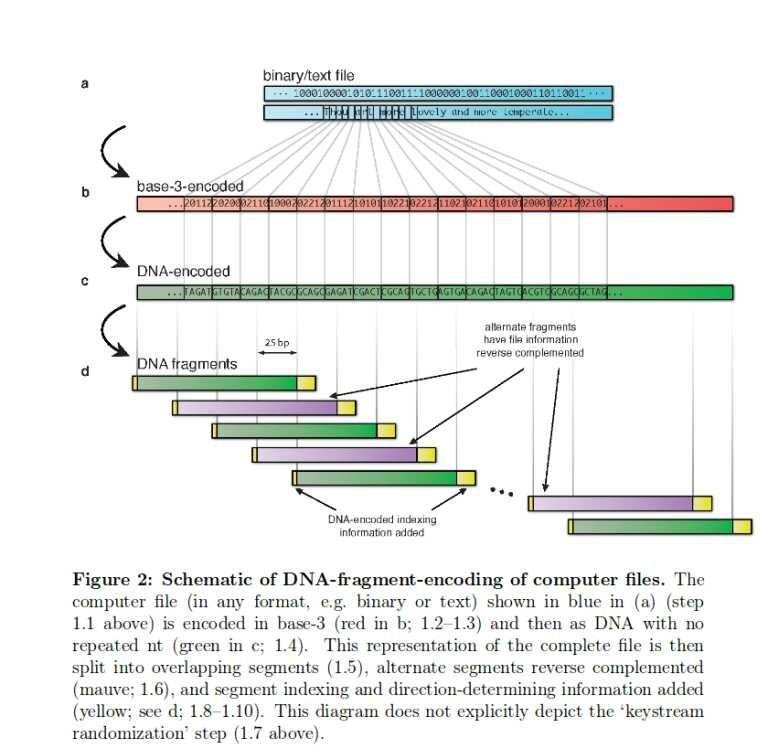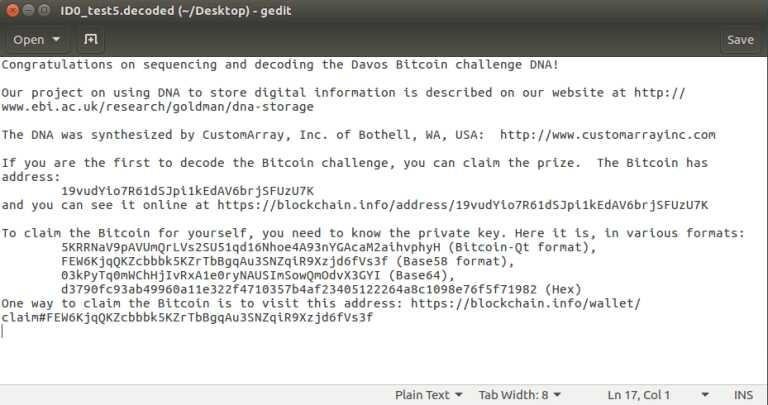
You are probably puzzled by the headline of this news and ask yourself, is it really possible to remove a bitcoin from a sequence of genetic information? Well the answer is affirmative and the computer microbiologist Sander Wuyts has just confirmed it.
Wuyts is the deserved winner of the challenge launched at the World Economic Forum Davos 2015 by the researcher at the European Institute of Bioinformatics (EBI), Nick Goldman, at the time he presented his latest discoveries in the storage of digital data in DNA sequences.
Goldman - together with his team of researchers - dismayed by the electrical, monetary and technological challenges involved in storing the huge amount of content that currently circulates digitally (around three zettabytes) -information that never stops growing- find a method that translates and encodes the binary information of the digital files to store it in DNA sequences. It was January 21, 2015, when he presented his work to the public, who presented the challenge.
A test tube containing DNA samples was delivered to each member of the audience. These DNA samples stored in code the private key of a portfolio with 1 bitcoin deposited. He who could decode the information contained in the DNA sample, sequence it and read it, would be the new owner of that bitcoin.
Bitcoin is a form of money that only exists in computers, and with cryptography, that is something that we can easily store in DNA. We buy a bitcoin and we encode the information in DNA. You can follow the technical description of our method and sequence the sample, decode the bitcoin. Whoever arrives there first and decodes it remains the bitcoin.
Nick Goldman
Group Leader, Goldman Research Group of the European Institute of Bioinformatics
image

Nick Goldman presenting the challenge in Davos 2015. Source: https://www.ebi.ac.uk/
Such was the challenge that the Ph.D. student in microbiology at the University of Antwerp, Sander Wuyts, managed to overcome. While Wuyts, who has spent years researching the bacterial universe through DNA, saw through YouTube the moment in which Goldman launched the challenge in 2015, it was not until December of this year, less than two months after the closure of the contest (moment in which the EBI would stay with the bitcoin) that Wuyts was driven by a tweet to search everywhere for one of the test tubes distributed that day to solve the riddle.
It was not the Goldman himself who answered Wuyts and sent him the DNA sample that appears in the image that crowns this article.
I thought this is the challenge for me! I tweeted to see if someone had a DNA sample left over, and Nick had one for me and sent it to me. My supervisor was very supportive in carrying out this parallel project (although he was surprised that he did it), so I contacted Ilumina for a sequencing kit and a colleague Eline Oerlemans offered to help me arrange the DNA sequencer. In the end it cost us nothing except time.
Sander Wuyts
Doctoral student in Computational Microbiology, University of Antwerp
Of course deciphering the riddle was not an easy task. Wuyts himself has prodigality of technical details all his successes and errors in the process of deciphering the message. While - according to his words - decoding is just the reverse process of coding, Wuyts had never decoded a message from a DNA sample to remove bitcoins.
The coding process performed by the EBI researchers is shown in the following image. From a text file with its parallel binary code, it is passed to a ternary coding system that is easier to translate to DNA coding, which works with the letters corresponding to the conventional nomenclature of genetic information, that is, A's, C's, G's and T's. This alphabetic system can not have any error or repetition at the risk that the machine that reads the DNA gets confused. Then, the information entered in fragments or blocks is divided to be mixed later. Putting them in order again to go back to the binary and make them readable, is the process undertaken by Wuyts.
image

Process of translation of binary and genetic code. Source: https://www.ebi.ac.uk
Long was this process of decoding. Even more so when the programming language handled by Wuyts was restricted to the outdated R, which took a long time to give results. Luckily, he had the support of his colleague Stijn Wittouck, whose knowledge of Python was essential to achieve the file run.
After a month of work, just one week before the closing date of the contest, about to throw in the towel, Wuyts managed to debug the error code, decoded the riddle and could read the encrypted message:
image

Message contained in the already decoded and readable genetic sample. Source: https://swuyts.files.wordpress.com
"Congratulations on sequencing and decoding the retro Davos Bitcoin DNA! (...) If you are the first to decode the Bitcoin challenge, you can claim the prize. The Bitcoin has the address: 19vudYio7R61dSJpi1kEdAV6brjSFUzU7K and you can see it online at https://blockchain.info/address/19vudYio7R61dSJpi1kEdAV6brjSFUzU7K. To claim the bitcoin for you, you need to know the private key. Here it is in various formats "
Wuyts says he took 20 minutes trying to figure out how to sweep the bitcoins to his wallet. And, checking the link of the transaction in the blockchain.info browser, we can know that it was successful and withdrew its bitcoin on January 14, 2018. In spite of everything, Wuyts does not maintain great confidence regarding the future of the mother cryptocurrency .
I did not earn thousands of euros. I won a Bitcoin. I probably change it, because I have my doubts about the long-term value of this cryptocurrency. What is more important is that before participating in this challenge I had my doubts about the viability of such DNA technology - but now I do not. Instead, I have a new perspective on DNA that can be coupled with my future research.
Sander Wuyts
Doctoral student in Computational Microbiology, University of Antwerp
The relationships between cryptocurrencies and genetic information are not new. Already at the beginning of December 2017 Intel said it would take advantage of cryptocurrency mining to sequence DNA. While the Encrypgen project seeks to maintain genomic records in blockchain for medical research.
As for Wuyts, it seems that he kept his word and sold the bitcoin he received as a reward for his intelligence and perseverance, since by reviewing the portfolio to which the winning bitcoin was sent, it is observed that a transfer was made of the only cryptocurrency he had .
@OriginalWorks
You got a 0.74% upvote from @allaz courtesy of @drakbirkenau!